This list includes the best among all Wi-Fi 6E mesh systems I’ve reviewed. Most importantly, they are the results of months, even years, in real-world usage.
While these are purpose-built mesh systems, in all cases, the router units can work as standalone routers. Still, if you’re living where a single broadcaster suffices, one of these best Wi-Fi 6E routers is more applicable. On top of that, keep in mind that you can upgrade any Wi-Fi 6 router to Wi-Fi 6E.
Wi-Fi 7 became official in the first days of 2024, but the new standard will still need a few years to mature. Until then, Wi-Fi 6E—an extension of Wi-Fi 6, which is, in my book, currently the best Wi-Fi standard to buy—is more affordable and delivers the same experience for most homes.
A Wi-Fi 6E mesh gives you a genuine taste of the new 6GHz band, particularly when used in a wired home, and is forward-compatible with any Wi-Fi 7 client and beyond.
Dong’s note: I originally published this frequently-revised piece on October 30, 2022, and last updated it on December 7, 2024.
Wi-Fi 6E mesh systems: A couple of important notes
Wi-Fi 6E has the same features and speed grades as Wi-Fi 6 but with an additional 6GHz band.
This band is cleaner and, therefore, can achieve the top speed more efficiently with better reliability. On the downside, the 6GHz has a noticeably shorter range than the 5GHz and 2.4GHz. And that makes things tricky for Wi-Fi 6E mesh systems—no band can work reliably as the backhaul without signal loss.
The point is this: If you’re looking into Wi-Fi 6E mesh with hopes of fast wireless performance (and rightfully so), it’s best to use it via wired backhauling—get your home wired! If wiring is not an option, you should stick with a tri-band Wi-Fi 6 system that supports UNII-4.
Extra: Fronthaul vs. backhaul
When you use multiple Wi-Fi broadcasters—in a mesh Wi-Fi system or a combo of a router and an extender—there are two types of connections: fronthaul and backhaul.
Fronthaul is the Wi-Fi signals broadcast outward for clients or the local area network (LAN) ports for wired devices. It’s what we generally expect from a Wi-Fi broadcaster.
Backhaul (a.k.a backbone), on the other hand, is the link between one satellite Wi-Fi broadcaster and another, which can be the network’s primary router, a switch, or another satellite unit.
This link works behind the scenes to keep the hardware units together as a system. It also determines the ceiling bandwidth (and speed) of all devices connected to the particular satellite Wi-Fi broadcaster.
At the satellite/extender unit, the connection used for the backhaul—a Wi-Fi link or a network port—is often called the uplink. Generally, a Wi-Fi broadcaster might use one of its bands (2.4GHz, 5GHz, or 6GHz) or a network port for the uplink.
When a Wi-Fi band handles backhaul and fronthaul simultaneously, only half its bandwidth is available to either end. When a Wi-Fi band functions solely for backhauling, often available traditional Tri-band hardware, it’s called the dedicated backhaul.
Generally, for the best performance and reliability, network cables are recommended for backhauling—wired backhauling, which is an advantage of mesh Wi-Fi hardware with network ports. In this case, a satellite broadcaster can use its entire Wi-Fi bandwidth for front-hauling.
A Wi-Fi 6E mesh system will work in a wireless configuration—even quite well if you live in an airy home. However, most of the time, your mileage will vary significantly in both real-world sustained rates and coverage.
With Wi-Fi 7 now officially available, chances are there won’t be new Wi-Fi 6E broadcasters in the future. With that, let’s check out the current, and likely the last, top five options listed in the recommended order with the best on top.
Top 5 best Wi-Fi 6E mesh systems
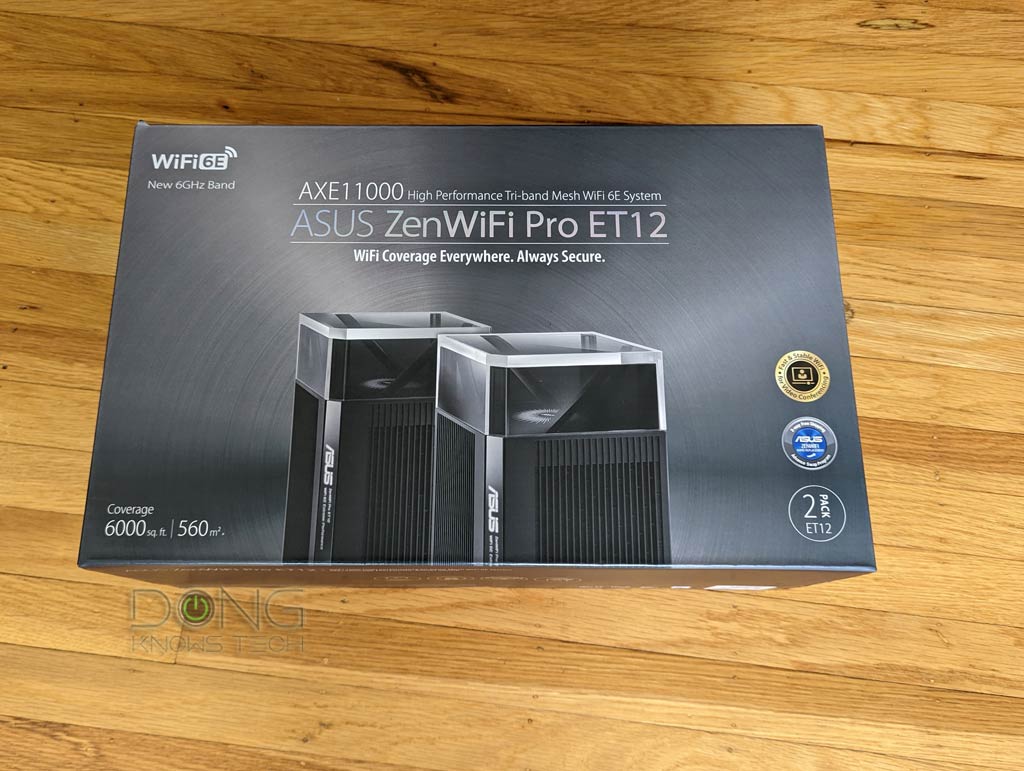 |  |  |  |  | |
| Name | Asus ZenWiFi Pro ET12’s Rating | TP-Link Deco XE200’s Rating | Asus ZenWiFi ET8’s Rating | Netgear Orbi RBKE960 Series’ Rating | Linksys AXE8400 Atlas Max’s Rating |
| Price | – | – | – | – | – |
| Rating | |||||
| Description | |||||
| Statistics | |||||
| Buy this product |
1. Asus ZenWiFi Pro ET12: True Multi-Gigabit wired mesh set
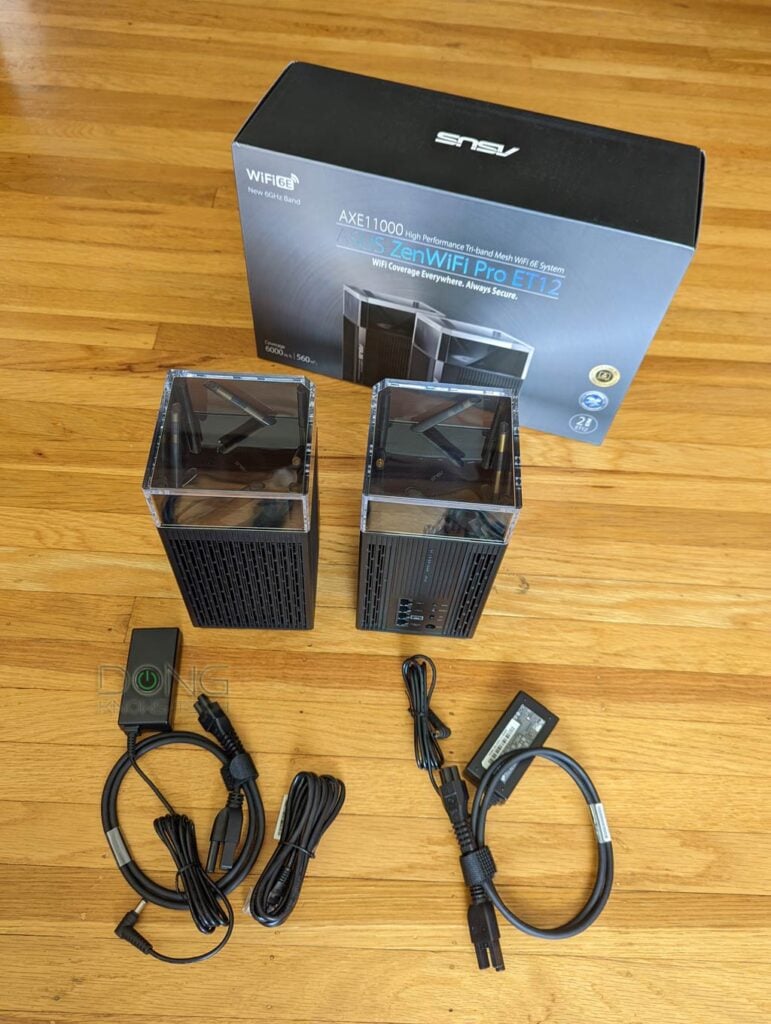
The ZenWiFi Pro ET12 is Asus’s second Wi-Fi 6E mesh system and is meant to supersede the ET8 (below) in hardware specs.
It remains a tri-band system without an additional band to work as backhaul, such as the case of the ZenWiFi Po XT12 Wi-Fi 6 counterpart.
Thanks to the top-tier Wi-Fi specs and the two 2.5Gbps Multi-Gig ports, the ZenWiFi Pro ET12 is also the best mesh Wi-Fi system with entry-level multi-Gigabit wired backhauling and can consistently deliver Gig+ Wi-Fi performance to Wi-Fi 6 and newer clients.
Asus ZenWiFi Pro ET12's Rating
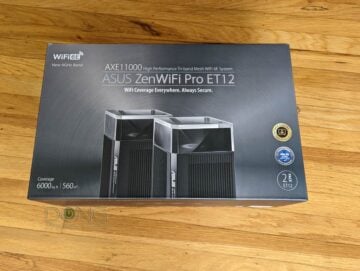
Pros
Wi-Fi 6E-ready, extensive Wi-Fi coverage with top performance in specific setups with possible fast Wi-Fi performance in certain setups
Dual Multi-Gig ports with multi-Gigabit wired backhauling, flexible port configurations
Excellent performance and coverage as a standalone router
Tons of useful features and settings, flexible Wi-Fi customization
Helpful mobile app; no login account required
Cool design
Cons
Bulky, no USB, only four network ports
Fluctuating performance as a fully wireless mesh due to the lack of a dedicated backhaul band
Short 6GHz range
Expensive, not wall-mount-ready
2. TP-Link Deco XE200: A solid mesh that’s somewhat a missed opportunity
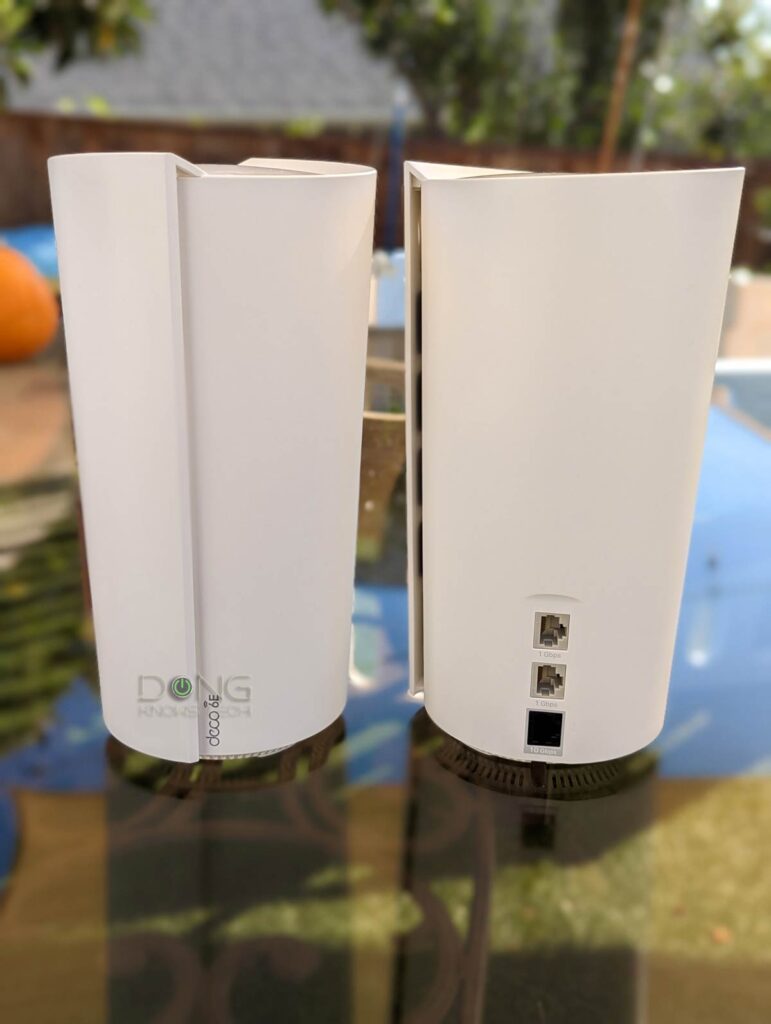
The Deco XE200 is the highest-tier Wi-Fi 6E mesh system in TP-Link’s popular Deco family. Unfortunately, having just one Multi-Gig port, it fails to be the ultimate mesh—there’s no chance for a Multi-Gig wired backhauling setup unless you use it in the AP mode with a multi-Gigabit non-Wifi router.
Still, for those with Gigabit or slower broadband, the XE200 is an excellent buy. Alternatively, consider the lesser yet similar TP-Link Deco XE75 or the Pro version if you have Gigabit-class broadband.
TP-Link Deco XE200's Rating

Pros
10Gbps port, 6GHz support, top-tier Wi-Fi, reliable Wi-Fi performance with extensive coverage
Easy to use; comparatively affordable
Good looking
Cons
Single Multi-Gig port, spartan Wi-Fi, and network customization
Fluctuating Wi-Fi speeds, Mobile app, and login account required; HomeShield Pro costs money
No USB port, impractical design
3. Asus ZenWiFi ET8: Excellent for a wired home with Gigabit broadband

The ZenWiFi ET8 is Asus’s Wi-Fi 6E alternative to the ZenWiFi XT8, which is a purpose-built Wi-Fi 6 mesh system for a fully wireless setup. In that sense, the ET8 is not an upgrade to the older cousin—it’s not great for a wireless configuration. Instead, like all Wi-Fi 6E systems, it’s an alternative for an airy home or one already wired with network cables.
The ZenWiFi ET8 is available as a 2-pack. Each unit can work as a standalone router for a small home, or you can mix the set with other same-specced AiMesh routers—such as the RT-AXE7800—to scale up the mesh coverage, preferably with wired backhauling. It works well in either case.
Like the Deco XE200 above, each ET8 router has only one Multi-Gig port—the entry-level 2.5Gbps—so there’s no chance of multi-Gigabit wired backhauling unless you use it in the AP mode for a non-Wifi router.
Alternatively, you can also consider the ZenWiFi ET9, which has slightly better hardware specs, more hardware options, and similar pricing.
Asus ZenWiFi ET8's Rating

Pros
Reliable and extensive coverage with possible fast Wi-Fi performance with wired backhauling
Wi-Fi 6E ready, Multi-Gig WAN, and Dual-WAN support
Excellent as a standalone router
Tons of useful features and settings, flexible Wi-Fi customization
AiMesh 2.0 support
Cons
Comparatively slow performance in most use cases
Modest 5GHz band specs
Short 6GHz range; unreliable with wireless backhauling
No Link Aggregation or Multi-Gig LAN port
Only one Multi-Gig port on each hardware unit
4. Netgear Orbi RBKE960 Series: A sticker shock with excellent performance

Available as a 3-pack—RBKE963 (white) or RBKE963B (black)—Netgear’s first quad-band Orbi Wi-Fi 6E system is insanely expensive, costing $1500 at launch—and you have the option to pay even more over the Armor add-on subscriptions.
Furthermore, it includes fewer features and settings than previous Orbi sets. In return, you’ll get substantial and uniquely quad-band hardware and support for Multi-Gig wired backhauling.
Netgear Orbi RBKE960 Series' Rating
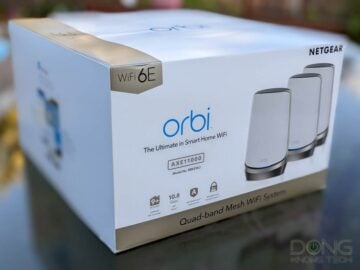
Pros
Powerful hardware with quad-band Wi-Fi and Multi-Gig wired backhaul support
Excellent Wi-Fi coverage, fast performance
Multiple Multi-Gig ports
More Wi-Fi networks than previous Orbis, including two additional virtual SSIDs
Easy to use
Cons
Expensive
No web-based Remote Management, few free features; mobile app (with a login account and even subscriptions) is required to be useful
Rigid Multi-Gig ports' roles, few Multi-Gig ports
The 2nd 5GHz band is unavailable to clients even with wired backhaul; no 160MHz channel width on 5GHz
Limited Wi-Fi customization, bulky design
5. Linksys AXE8400 Atlas Max 6E: A reliable Wi-Fi 6E mesh system
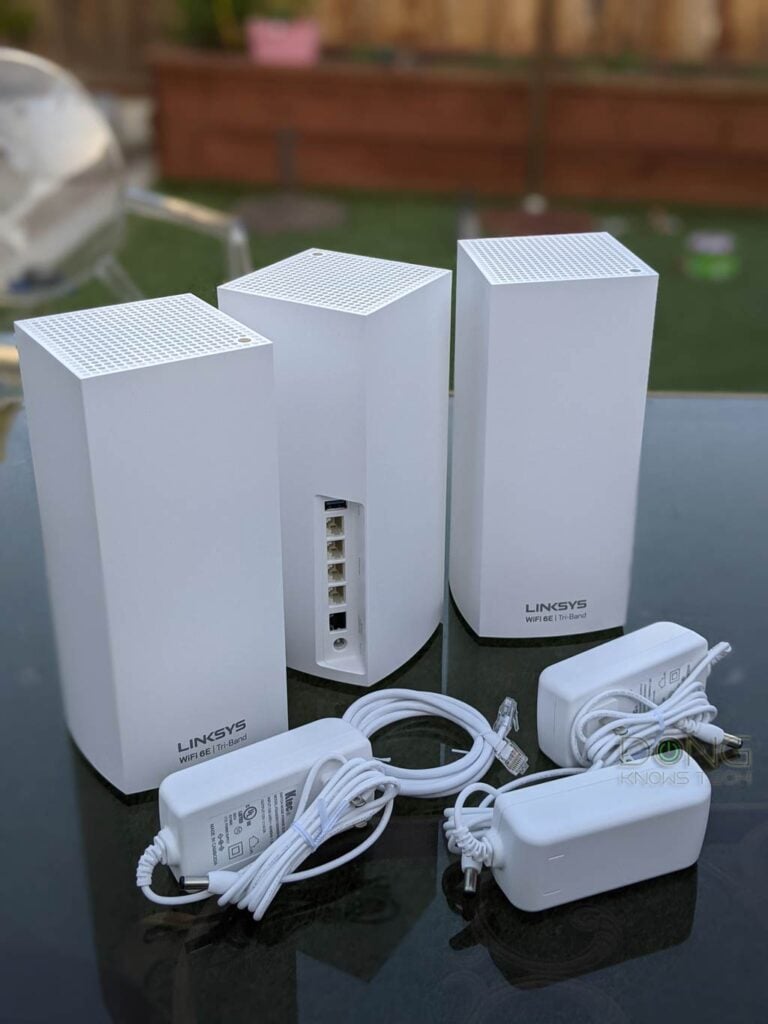
Besides the MR7500 router, the AXE8400 Atlas Max 6E is Linksys’s 2nd 6E solution. The mesh consists of three identical tri-band 6E broadcasters, model MX8500. Each can work as a standalone router, but you can combine them into a system to deliver coverage of all three bands (2.4GHz, 5GHz, and 6GHz) in a large property.
Linksys AXE8400 Atlas Max's Rating
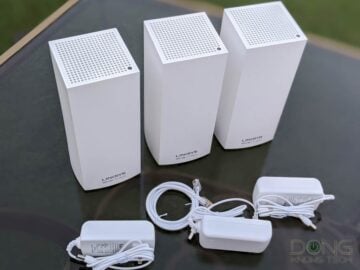
Pros
Wi-Fi 6E-ready
Reliable performance, extensive coverage
5Gbps WAN port
Excellent NAS performance when hosting external storage device(s)
Separate SSID for each band
Cons
Expensive
Comparatively slow mesh Wi-Fi speeds in homes with walls
Limited Wi-Fi settings and features, mobile app coercion
No Multi-Gig LAN port at the primary router, Dual-WAN, or Link Aggregation
No setting backup and restore
Best Wi-Fi 6E mesh systems: The takeaway
Wi-Fi 6E is the stop-gap extension that bridges Wi-Fi 6 to Wi-Fi 7. With the 6GHz’s innate short range, it’s a standard designed for homes without (a lot of) walls or already equipped with network cables. Otherwise, a Wi-Fi 6E mesh system will not deliver faster Gigabit performance.
Again, it’s best to use Wi-Fi 6E mesh with wired backhauling. If you have no network cables, Wi-Fi 6 hardware with an additional 5GHz band that can work as a dedicated backhaul, especially those supporting the UNII-4 portion of the 5GHz spectrum, is recommended.



Hi Dong,
Would you still buy TP-Link given the incoming ban?
XE75 is on sale at present and at an all time low.
Thank you
There’s no incoming ban, Matthew. That’s not a done deal. As for what to get or not get, it’s your call.
Though Wi-Fi 6E or even a solid Wi-Fi 6 mesh might have been a better fit for my current situation (1 gig symmetrical fiber, laptop with Intel BE200 Wi-Fi 7 upgrade still limited by Win11, Wi-Fi 6E phone, the rest gigabit wired or Wi-Fi 5 max), one major issue with nearly all meshes here made me go for a low-end Wi-Fi 7 mesh (Deco BE63) instead: Not enough 2.5GbE ports for Gig+ for both WAN & wired backhaul. “Gigabit” Ethernet is capped at just over 940 Mbps; my ONT gets around that with a 2.5GbE port (just over 1 gig at the router), but with only one such port at the router the 940 Mbps limit still affects wired backhaul. Though it’s not much at 1 gig Internet, I expect to reach 1.2 or even 2 gig (here or elsewhere) during the mesh’s life so avoiding the 940 Mbps limit is important to me. The only mesh in this roundup with two 2.5GbE ports per node, the ZenWiFi ET12 Pro, is far more expensive as a 2-pack than the BE63 with four 2.5GbE ports per node — enough to overcome Asus’ admin & security advantages over TP-Link IMO. I also seriously considered the ZenWiFi ET8 (and XT8) plus the Deco XE75 Pro, but the 940 Mbps limit and other issues with the Zens pushed me to make the leap to the BE63. I have run into a few minor issues, but they pale in comparison to what I avoided by skipping Wi-Fi 6E for Wi-Fi 7.
I have two 1350 sqft homes on a 7500 sqft residential lot. Ideally, I’d love to be able to create one wifi network that serves both properties, wireless (or wired when I tear out my driveway) backhaul options are feasible, but I’m at a loss as to which system is ideal for this.
WIFI 6 seems to only work at very short ranges without walls (my houses are those weird kind that actually have walls :-), which seems to indicate I’m at 2.4 or 5 ghz regardless of the mesh system used, correct?
Do you have a recommendation for this setup? I could in theory bridge the two homes with an exterior node in a carport; however, I’d prefer to keep the nodes inside. That means jumping nodes from one house to the other is a 45+ft jump between two walls (one on either side). I’d REALLY appreciate and direction here.
You need to run a network cable to connect the two, Luke. There’s no Wi-Fi solution for this. More on Wi-Fi range in this post.
By the way, Wi-Fi 6 uses 5GHz and 2.4GHz bands. The 6GHz band is avaible in Wi-Fi 6E and Wi-Fi 7.
Good luck!
Thank you, Dong. I read both articles you linked to regarding Wi-Fi range and network cables. It looks like all wired backhaul broadcasters in a Wi-Fi 6E or 7 setup. Wi-Fi 7 looks like it can get really expensive quickly, but I’m open to exploring it if it’s the rights setup based on Wi-Fi 7’s AFC that boosts the 6 Ghz range.
Do you have a recommended setup that will allow a 45+ ft jump between two nodes between the two houses (so, two walls to cross)? I imagine I’ll need 2 nodes in the front house and 2 nodes in the back house. I’m already wired for 3 nodes in the front house and zero in the back house, so I’ll need to run ethernet cable between the two houses in the ground with any setup. Alternatively, I could use a weather resistant node outside as a bridge between the two houses.
I appreciate your expert opinion and specific advice and would thankfully Venmo you to give me personalized recommendations based on my house setup.
What part of “There’s no Wi-Fi solution for this.” in my previous reply didn’t you understand, Luke? Also, I didn’t start this site to solicit a consulting service, and I have no tips on reading comprehension.
That’s pretty snarky response from someone I have always thought was a helpful, understanding person. Apologies if we are missing each other on terminology, but there is clearly a way to offer a Wi-Fi connection with one SSID for a much larger property than a 7500 sqft lot with two 1350 sqft buildings sitting on it. Many businesses and campuses I have been on have no issues broadcasting Wi-Fi across an area many times larger than this. I think I’ve seen Ubiquity in many of those setups, but I would think such a setup might not be needed for this small of a property.
Possibly we are crossing paths on terminology or possibly you’re missing something in my question, but I apologize if I offended you in some way by asking how I can send you money for your assistance in answering my question.
Not snarky, but direct, clear and in kind.
I’m not a shrink but it’s insulting to dangle money when asking for help, especially from a person you thought to be “helpful”. Your behavior was also insulting to the idea of charity itself. Keep that in mind.
Like I said before, you need to run a cable, that’s the cheapest and most effective solution for you. I speak as one of those who run various Wi-Fi networks in “many businesses and compasses” you mentioned for a living. There are ways to do this wirelessly but you likely don’t want to pay for the hardware, the labor cost, or the consulting fees. Else, talk to a local professional.
Hello Dong,
Thanks for your great guides. I’ve really enjoyed your guides on how to wire the house and which mesh to go for. I’m going to go for a wired backhaul mesh system but was curious why you don’t review any Tenda products? In the UK they are a fraction of the price compared the usual products you review (e.g. a 3 pack 6E system is less than £300) so i was wondering if there is a downside that comes with that price as on paper they seem to be on par.
Tenda is generally not available in the U.S., Paul. Also, stuff is cheap for a reason. I’ve had some interesting experience with Tenda before.
Hello Dong, I’m not as technical as you or others that comment on here. I get confused about the recommendations for Mesh Systems. Wiring my 2 story 3000sqft house is not an option. My 1gig Fiber comes in on one side of the house and the TV Streaming is done on the opposite side of the house. I need a WI-FI 6/6E/7 Mesh system with BIG range 100% wireless. I want something that I won’t have to change out in five years. Thank you
I don’t have any recommendation for you Lionel — I generally don’t comment on specific situations because there’s no way to know without being there. You can start with this post to educate yourself before making the decision, or hire a local professional. By the way, there’s no need to post the same comment under multiple posts.
Hi Dong, Happy New Year!
Regarding the ZenWiFi Pro ET12, which multi-gig 16 port Ethernet switch would you recommend I purchase for use with a wired backhaul for home use? Thanks!
I’m not aware of any 16-port option, Kelly. All those I’ve tested are here. You can always use two switches together.
Happy New Year!
Great post…
I have 2G Internet, and my ISP modem cannot be changed to Bridge. It only has one 2.5G port, currently connected to a 10G QNAP switch in my office for Mac Pros, Mac Studio, and a NAS. My old Velop MESH system is connected to a Gigabit port on the modem, and I have Ethernet backhaul to the two floors above.
Will this work:
– I add another 2.5/10G switch to the modem,
– I connect my existing 10G QNAP switch to the new switch,
– I also connect three MESH nodes to this switch – one is in the basement, one is hardwired to the ground floor, and one is hardwired to the top floor.
For this setup, which WiFi 6E MESH system would you recommend – I can’t afford spending CAD1000s on this?
What you have is not a “modem”, Bo. It’s a gateway. And I assumed you meant you had 2Gbps Internet. It’s important to call stuff correctly. This post will help.
You’re right…
I will put the MESH system into bridge mode – which is what I’m doin with my Velop system right now. My Velop is old, only WiFi5, and can’t handle the 50ish devices I have on the system.
Knowing that, can I add a 10G switch between the Gateway (Router) and the MESH solution (in bridge mode), ensuring a fast backhaul to the other MESH nodes as well as my office with the 10G QNAP Switch?
And, what would be a good sub-$1K solution for this setup?
Thanks in advance.
That’s the AP mode you’re talking about. Read the post in its entirety. You’re taking about a double NAT, which I don’t recommend. But it’s your call.
On my Velop setup the AP mode is called Bridge, and it’s basically turning all DHCP functions off. The ISP Gateway does all the DHCP work, and the Velop system delivers WiFi, but DHCP is from the ISP Gateway.
It works with the Velop system, no double NAT, no issues with port forwarding, and the only funky thing is that all WiFi devices look like they are connected via Ethernet on the Gateway – to it, they are.
I want to find out if I get a TP-Link system for instance, can I turn all three nodes into AP mode, where they all three are connected to a 10G switch on the Ethernet backhaul, and the switch is connected to the Gateway’s 2.5G Ethernet port? Basically allowing all three nodes access to multi-gig internet…
Believe it or not, Bo, I’m aware of that. It’s the AP mode you were talking about. For any other system, read the reviews. Please respect the comment rules.
You mention that these systems are best in a wired setup.
Do you have a list or recommendation for best non-wired system?
One of these, Brian. Generally, you want a dedicated backhaul band. But getting the place wired is always the best.
Thank you!
Now that we’re almost at the end of this year, are there any WiFi 6e routers that you really like that you would add to this list?
This list is up to date, Kelly.
Do any of these allow multiple SSIDs with custom VLANs, so I can have one main SSID, one for IoT devices (on its own separate VLAN), and one for guests? Or do I have to go for the prosumer/enterprise ones (Ubiquiti, TP-Link Omada, EnGenius, etc) for that?
Why do you need one for IoT? That’s totally nonsensical, Daniel — More here. Once you’ve read that, you’d know that any of these will work for your needs.
I have a separate VLAN for wired IoT devices (cameras and other things) to isolate them from the rest of my network and from the internet, so I’d like to use the same VLAN for wifi IoT devices too.
I’ve also got a non-IPv6 VLAN because some devices (like Google smart speakers) can misbehave on IPv6, and need to be able to use that VLAN for wifi devices too.
You can safely turn IPV6 off and use only IPV4 for the local network — it doesn’t do anything. You can turn that off at the router. All Asus routers allow you to crate up to 3 additional (Guest) SSIDs per band. Assuming you’ve read the post I linked above, you know what to do with those. Good luck!
I need IPv6 so disabling it is not an option for me. I have a few servers ‘in the cloud’ that only use IPv6, so without IPv6 I can’t access them.
Thanks for the information about the additional SSIDs on the Asus routers. That’s good to know.
That’s not how it works. Your router will handle IPv6 on the WAN side. It’s OK to turn that off for the local devices. Try it.
Hi Dong,
Thanks for all the information but im still confused why system to buy.
I currently have Apple Airport Extreme and 2 x Aiport Express. They work great internally but coverage for the garden is weak. I have gigabit internet the wifi speeds are lacking. I live in a 3 bedroom house with back garden of 30 feet in length.
I require a mesh system that has a minimum of 3 usable ethernet ports. Which would you recommend?
You need a mesh system with Multi-Gig ports. So, check out this post.
If you want something low-cost. Check out the best lists in the Related Stories box.
Hi Dong,
The information you provide on your reviews are outstanding, Thank You!
I have a 3,500 sqft single story ranch home (horseshoe layout) centered on a half-acre lot with Xfinity 1.2 Gbps service, and an Arris Surfboard S33 cable modem. My house is not wired, however I plan to do so in the next year or two.
Both my wife and I work from home and are always on our computers (often in Zoom meetings). We have 2 kids and we all stream and game. And we also spend time in our yard streaming music and shows on the projector via Wi-Fi (but it’s spotty).
I am looking to upgrade my mesh system to a Wi-Fi 6e that provides good seamless coverage, range, speed, and stability -> at first we would run it wireless until I can get the house wired.
I’m looking to spend around $500, and I was hoping you could provide a recommendation(s)?
Wi-Fi 6E WON’T help your situation, Martin. It’s actually quite complicated and I wish I had the answer for you… I’d recommend you start with this post, happy to answer follow-up questions after that — make sure you read and follow the comment rules above, though. Good luck!
Why isn’t the Eero Pro 6E on this list?
Because it’s the “best list”, Rob. eero is the worst. 🙂
Hi. Would this config work (well) with tp-link 75 pro with single 2.5gb port: use cable box in router mode-> multi-gig switch -> each mesh node (Inc master node) connected into switch via their 2.5gb wan port ?
TP-Link Deco generally has auto-sensing ports, Chris. So, the setup will work well as long as you have Gigabit or slower broadband. More here.
Thx – I read the link, but I don’t understand the ‘Gigabit or slower broadband’ point….?
I reread your original question basically it seems you want to use the cable gateway as your main router. If so, you need to use the Deco in the AP mode. More here.
Dong, thank you for the informative information on mesh systems. Because Asus does not sell an individual ET8, Amazon sells one XT8 router with an ET8 two-pack as a replacement for a three-pack. Will using the XT8 as the router and the two ET8s as the nodes realize the full potential of the 6e capabilities of the ET8s?
Thanks for all your information. You have one of the best tech and review sites around.
I’ve never tried that, Patrick, but chances are the XT8 will use its 5GHz-2 band to manage the ET8’s 6GHz band — they might not even work together since it’s never good to mix Wi-Fi 6 and 6E wirelessly. Check out this post for more. Your best bet is to use them in the router to AP mesh mode as described here, if your home is wired. Good luck!
Thanks for the quick response. I need to connect wirelessly, so it may make better sense to use a WIFI 6 system until I have more 6E devices.
Thanks.
I’d just go all XT8, Patrick.
Dong,
Thanks so much for sharing your rich knowledge base.
You ended with:
“If you have no network cables, getting a system with an additional 5GHz band that works as the dedicated backhaul — namely, the Netgear RBKE960 series, for now– is the best approach.”
I understand this, but, here is my situation:
I’ve just moved to a 3300 sq ft, one floor condo with (unfortunately) many walls.
My current two node (working wirelessly) tri-band Linksys mesh system (24 Ghz + 5Ghz + 5Ghz) – which was working okay – just died. So I need a new mesh system yesterday.
The condo is extensively wired with both coaxial and CAT 5 cables that come together in a “command central” wall box array. HOWEVER, I am not techy and cannot set up a wired system myself nor can I get some one in who can any time soon.
So, I wanted to get a 6E mesh quad band system that could initially be set up to work entirely wirelessly and then potentially later be re-set up in a wired configuration.
From what I read, in my situation, the problem with the Netgear RBKE960 (besides being crazy expensive) is that its second 5 Ghz band is permanently and unalterably set up as a backhaul band and thus, never available for client use. This is not desirable if the system would later be converted to one where all the backhaul could be wired.
Based on what I have read, I think that while the system is being used entirely “wirelessly”, I really should have a quad band system.
Given all this, do you have other (possibly less expensive) 6E mesh quad band systems to suggest that might better circumstances like mine?
Thanks again for sharing your plethora of knowledge.
If you have wired backhauling, which you do, I’d not go with this Orbi, or any Orbi. Pick one Tri-band option among these instead. One of the ZenWiFis is probabaly best for your situation.
I’ve had the Zen ET12 for almost a month now and it’s the first time I’ve ever been 100% satisfied with my wireless setup in my house…speed, coverage, and stability are great everywhere. Previous setups (Asus RT-66, Netgear X6 with TP-Link Extender, Nest) always had issues with range, speed, and/or stability in my 2100 sq foot house, partly because I could never place a router centrally (all coax outlets at edges of house, and open circular floor plan with stairs in middle makes it impossible to put something central).
Got the Zen ET12 based partly on your review. Original plan was to have satellite wired with MOCA given there’s a cable outlet where the satellite is, and running ethernet, while not impossible, would be a lot of work. Unfortunately I discovered that the coax in my house is so bad that it can’t handle even a single splitter…causes cable modem signal issues and can’t get a stable high speed connection with MOCA. I thought that I would have to return the ET12 for an XT12 given the limited range of the 6 ghz band for backhaul.
However, I decided just to try the wireless backhaul on “Auto”, and surprisingly it’s been choosing that band for backhaul and it’s been performing quite well. RSSI hovers around -70 dbm and it never switches to the 5 ghz band. This is despite being almost at opposite ends of the house. I was a bit shocked given the limited range of the 6 ghz band. It probably helps that I have the main router up high on a shelf in an open loft, and it’s an open circular floor plan so neither the router or satellite are in an enclosed room even though they aren’t in line of sight. Speeds for my Wifi6 laptop on the 5 ghz band hit around 800 mbps at the satellite in the family room (1.2 gig Xfinity plan), which is plenty for my needs for that room Thus I’m sticking with the ET12 and the wireless backhaul. And if I ever want to open up that 6 ghz band for clients (only 6E client I have is my Samsung phone which I don’t care about being on 6 ghz), then I’ll look into running ethernet cable to that part of the house. I foresee this setup working well for me for quite a while now.
Thanks again for your thorough reviews.
Sure, James. Glad it’s working out. But yes, linking the hubs using a Multi-Gig wired backhaul will make things even *much* better, especially considering your Gig+ broadband. Cheers! 🙂
Dear Dong Ngo,
not waiting for until it gets cheaper, but unto a new tech altogether (one wireless that does not fry water in brains!)
All the best!
Richard
No wireless fries water in your brain, Richie. 🙂
Dong
How do the new Google Nest Pro routers work in a backhaul config
I mentioned that it the review. Give it a read!
Wi-Fi 6E Mesh System raises a question to backward compatibility for IoT that still require 2.4 GHz.
I’m asking if a Wi-Fi 6E-router has inherent support for 2.4GHz
or
it will have be a tri-band router to have a 6GHz + 5GHz + 2.4GHz built-in bands?
Other than a few Wi-Fi 6E upgrade hardware broadcasters, all Wi-Fi 6E hardware has built-in support for previous Wi-Fi standards (and bands), Liviu. More in this post.
Hi Dong,
Thank you for your time and writing these great articles.
I am in a situation where I have partial wired/wireless backhaul. I currently have the Orbi RBK753 and have one satellite hardwired to the router at the opposite end of the house (3,300 Sq. ft) on the second floor, while the other satellite is not wired and is 40 feet from the router with a clear path to the router. Also, we will be getting fiber internet with Gig+ speeds. You mentioned the Asus or the Linksys being the best options when doing a partial backhaul. I’m more interested in the Asus because of the AiMesh. would the ET8 be a good option and just purchase a compatible/additonal AiMesh device, or is the AXE 8400 Linksys a better option? Or is there something better?
Thank you
I think you should stay with the Orbi for now, Glen, and see how things go first. To get Gig+ (or faster), you first need to get the house fully wired and then use hardware with Multi-Gig ports, which can be quite an investment. When you’re ready, you can check out one of these AiMesh options.
Stay away from ET8’s! They are not well supported and do horribly with Asus’ firmware and lots of devices (50+) (think IoT devices like bulbs, switches, cameras, laptops, computers, TVs, … 50 is easy to get to in a 4 person home). With Merlin-gnuton modified firmware, they’ve been useable for the first time this year, but yet I find myself this very minute shopping for something else because it has once againt decided to stop working and reboots aren’t doing it. 2.4ghz is all but dead now. Half my house stopped working! I have been battling this for 2 years.
That seems to have little to do with the system, but likely your abuse of “smart” devices. More here. In other words, if true, no Wi-Fi system will work for your case.
Very informative article as always.
I’m reaching to inquire about a bottom line for one who would like to install a fresh Mesh system:
1) Would you say that the performance tested by you for router and satellites is the best parameter for comparison (except specific features one may want to use)?
2) There is a recent review of mesh systems (brands) comparison? (I did noticed Synology last update – dongknows.com/synology-mesh-review/#more-5079)
3) What article would you recommend reviewing for selecting a final router and its matching satellites?
Here’s how I test Wi-Fi devices, Liviu. The charts in a review generally include the scores of previous products.
This post will help you more on how to pick a mesh system. Follow the best lists (in the related posts) for options.
Good luck!
Thanks, Dong. Shortly after posting that question, I realized the same. 🙂 Thanks for the suggestions.